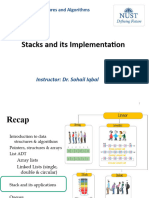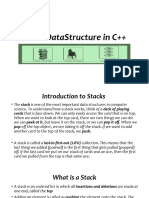Array Implementation of Stack
Stack is a linear data structure that follows a particular order in which the operations are
performed. The order may be LIFO(Last In First Out) or FILO(First In Last Out).
Mainly the following four basic operations are performed in the stack:
1. Push: Adds an item to the stack. If the stack is full, then it is said to be an Overflow
condition.
Algorithm for push:
begin
if stack is full
return
endif
else
increment top
stack[top] assign value
end else
end procedure
2. Pop: Removes an item from the stack. The items are popped in the reversed order in
which they are pushed. If the stack is empty, then it is said to be an Underflow condition.
Algorithm for pop:
begin
if stack is empty
return
endif
else
store value of stack[top]
decrement top
return value
Array Implementation of Stack 1
end else
end procedure
3. Peek or Top: Returns the top element of the stack.
Algorithm for peek:
begin
return stack[top]
end procedure
4. isEmpty: Returns true if the stack is empty, else false.
Algorithm for isEmpty:
begin
if top < 1
return true
else
return false
end procedure
How to understand a stack practically?
Array Implementation of Stack 2
There are many real-life examples of a stack. Consider the simple example of plates stacked
over one another in a canteen. The plate which is at the top is the first one to be removed, i.e.
the plate which has been placed at the bottommost position remains in the stack for the
longest period of time. So, it can be simply seen to follow the LIFO/FILO order.
Time Complexities of operations on the stack: push(), pop(), isEmpty() and peek() all take
O(1) time. We do not run any loop in any of these operations.
Applications of the stack:
Balancing of symbols
Infix to Postfix /Prefix conversion
Redo-undo features at many places like editors, photoshop.
Forward and backward features in web browsers
Used in many algorithms like Tower of Hanoi, tree traversals, stock span problems,
and histogram problems.
Backtracking is one of the algorithm designing techniques. Some examples of
backtracking are the Knight-Tour problem, N-Queen problem, find your way through a
maze, and game-like chess or checkers in all these problems we dive into someway if
that way is not efficient we come back to the previous state and go into some another
path. To get back from a current state we need to store the previous state for that purpose
we need a stack.
In Graph Algorithms like Topological Sorting and Strongly Connected Components
In Memory management, any modern computer uses a stack as the primary management
for a running purpose. Each program that is running in a computer system has its own
memory allocations
String reversal is also another application of stack. Here one by one each character gets
inserted into the stack. So the first character of the string is on the bottom of the stack
and the last element of a string is on the top of the stack. After Performing the pop
operations on the stack we get a string in reverse order.
Implementation:
There are two ways to implement a stack:
Array Implementation of Stack 3
Using array
Using linked list
Implementing Stack using Arrays
/* C++ program to implement basic stack
operations */
#include <bits/stdc++.h>
using namespace std;
#define MAX 1000
class Stack {
int top;
public:
int a[MAX]; // Maximum size of Stack
Stack() { top = -1; }
bool push(int x);
int pop();
int peek();
bool isEmpty();
};
bool Stack::push(int x)
{
if (top >= (MAX - 1)) {
cout << "Stack Overflow";
return false;
}
else {
a[++top] = x;
cout << x << " pushed into stack\n";
return true;
}
}
Array Implementation of Stack 4
int Stack::pop()
{
if (top < 0) {
cout << "Stack Underflow";
return 0;
}
else {
int x = a[top--];
return x;
}
}
int Stack::peek()
{
if (top < 0) {
cout << "Stack is Empty";
return 0;
}
else {
int x = a[top];
return x;
}
}
bool Stack::isEmpty()
{
return (top < 0);
}
// Driver program to test above functions
int main()
{
class Stack s;
s.push(10);
s.push(20);
s.push(30);
cout << s.pop() << " Popped from stack\n";
//print all elements in stack :
cout<<"Elements present in stack : ";
Array Implementation of Stack 5
while(!s.isEmpty())
{
// print top element in stack
cout<<s.peek()<<" ";
// remove top element in stack
s.pop();
}
return 0;
}
Output :
10 pushed into stack
20 pushed into stack
30 pushed into stack
30 Popped from stack
Top element is : 20
Elements present in stack : 20 10
Pros: Easy to implement. Memory is saved as pointers are not involved.
Cons: It is not dynamic. It doesn’t grow and shrink depending on needs at runtime.
Implementing Stack using Linked List:
// C++ program for linked list implementation of stack
#include <bits/stdc++.h>
using namespace std;
// A structure to represent a stack
class StackNode {
public:
int data;
StackNode* next;
};
Array Implementation of Stack 6
StackNode* newNode(int data)
{
StackNode* stackNode = new StackNode();
stackNode->data = data;
stackNode->next = NULL;
return stackNode;
}
int isEmpty(StackNode* root)
{
return !root;
}
void push(StackNode** root, int data)
{
StackNode* stackNode = newNode(data);
stackNode->next = *root;
*root = stackNode;
cout << data << " pushed to stack\n";
}
int pop(StackNode** root)
{
if (isEmpty(*root))
return INT_MIN;
StackNode* temp = *root;
*root = (*root)->next;
int popped = temp->data;
free(temp);
return popped;
}
int peek(StackNode* root)
{
if (isEmpty(root))
return INT_MIN;
return root->data;
Array Implementation of Stack 7
}
// Driver code
int main()
{
StackNode* root = NULL;
push(&root, 10);
push(&root, 20);
push(&root, 30);
cout << pop(&root) << " popped from stack\n";
cout << "Top element is " << peek(root) << endl;
cout<<"Elements present in stack : ";
//print all elements in stack :
while(!isEmpty(root))
{
// print top element in stack
cout<<peek(root)<<" ";
// remove top element in stack
pop(&root);
}
return 0;
}
Output:
10 pushed to stack
20 pushed to stack
30 pushed to stack
30 popped from stack
Top element is 20
Elements present in stack : 20 10
Array Implementation of Stack 8
Pros: The linked list implementation of a stack can grow and shrink according to the needs at
runtime.
Cons: Requires extra memory due to involvement of pointers.
Array Implementation of Stack 9
























































































